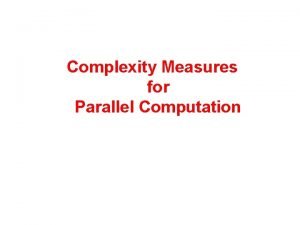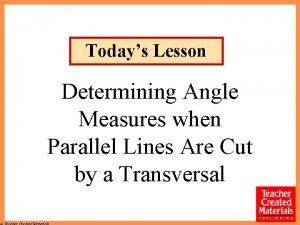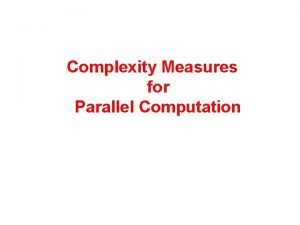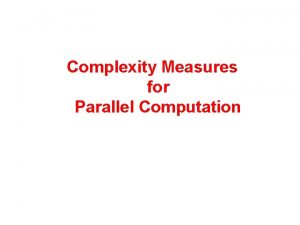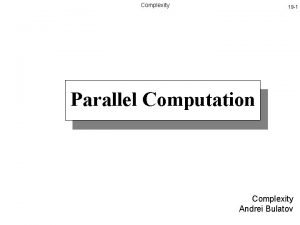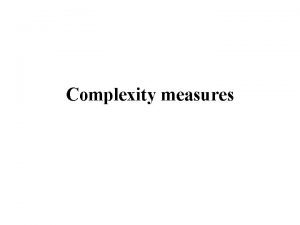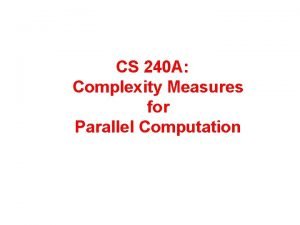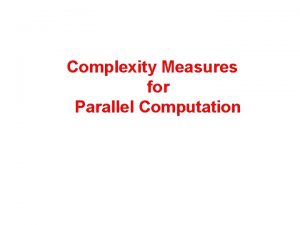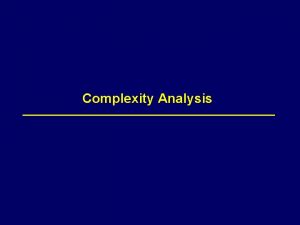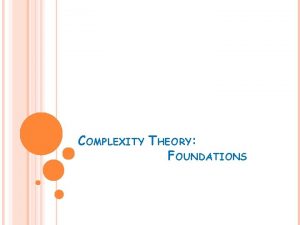Complexity Measures for Parallel Computation Work and span













- Slides: 13

Complexity Measures for Parallel Computation

Work and span TP = execution time on P processors

Work and span TP = execution time on P processors T 1 = work

Work and span TP = execution time on P processors T 1 = work T∞ = span* *Also called critical-path length or computational depth.

Work and span TP = execution time on P processors T 1 = work T∞ = span* WORK LAW ∙TP ≥T 1/P SPAN LAW ∙ TP ≥ T ∞ *Also called critical-path length or computational depth.

Series Composition A B Work: T 1(A∪B) = T 1(A) + T 1(B) Span: T∞(A∪B) = T∞(A) +T∞(B)

Parallel Composition A B Work: T 1(A∪B) = T 1(A) + T 1(B) Span: T∞(A∪B) = max{T∞(A), T∞(B)}

Speedup Def. T 1/TP = speedup on P processors. If T 1/TP = (P), we have linear speedup, = P, we have perfect linear speedup, > P, we have superlinear speedup, (which is not possible in this model, because of the Work Law TP ≥ T 1/P)

Parallelism Because the Span Law dictates that TP ≥ T∞, the maximum possible speedup given T 1 and T∞ is T 1/T∞ = (potential) parallelism = the average amount of work per step along the span.

Complexity measures for parallel computation Problem parameters: • n index of problem size • p number of processors Algorithm parameters: • tp running time on p processors • t 1 time on 1 processor = sequential time = “work” • t∞ time on unlimited procs = critical path length = “span” • v total communication volume Performance measures • speedup s = t 1 / tp • efficiency e = t 1 / (p*tp) = s / p • (potential) parallelism pp = t 1 / t∞

Laws of parallel complexity • Work law: tp ≥ t 1 / p • Span law: tp ≥ t∞ • Amdahl’s law: • If a fraction f, between 0 and 1, of the work must be done sequentially, then speedup ≤ 1 / f • Exercise: prove Amdahl’s law from the span law.

Detailed complexity measures for data movement I Moving data between processors by message-passing • Machine parameters: • a or tstartup latency (message startup time in seconds) • b or tdata inverse bandwidth (in seconds per word) • between nodes of Triton, a ~ 2. 2 × 10 -6 and b ~ 6. 4 × 10 -9 • Time to send & recv or bcast a message of w words: • tcomm total commmunication time • tcomp total computation time • Total parallel time: tp = tcomp + tcomm a + w*b

Detailed complexity measures for data movement II Moving data between cache and memory on one processor: • Assume just two levels in memory hierarchy, fast and slow • All data initially in slow memory • m = number of memory elements (words) moved between fast and slow memory • tm = time per slow memory operation • f = number of arithmetic operations • tf = time per arithmetic operation, tf << tm • q = f / m average number of flops per slow element access • Minimum possible time = f * tf when all data in fast memory • Actual time • f * tf + m * tm = f * tf * (1 + tm/tf * 1/q) • Larger q means time closer to minimum f * tf
 Time space complexity of algorithm
Time space complexity of algorithm Work and span
Work and span Text complexity qualitative measures rubric
Text complexity qualitative measures rubric Repeated measures design
Repeated measures design Transversal of parallel lines find angle measures
Transversal of parallel lines find angle measures Like parallel
Like parallel Parallelism
Parallelism A parallel sentence
A parallel sentence Parallel structure def
Parallel structure def Parallel structure english definition
Parallel structure english definition Section 4 review physical science
Section 4 review physical science Iso 22301 utbildning
Iso 22301 utbildning Typiska novell drag
Typiska novell drag Nationell inriktning för artificiell intelligens
Nationell inriktning för artificiell intelligens

